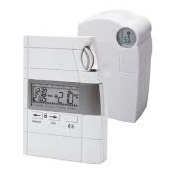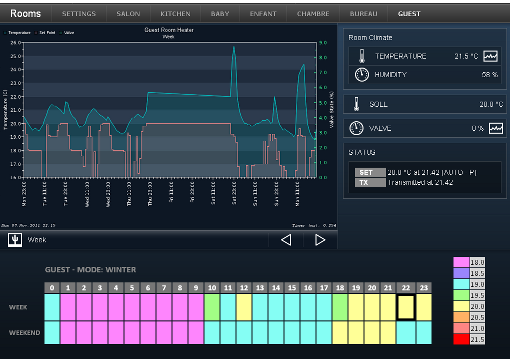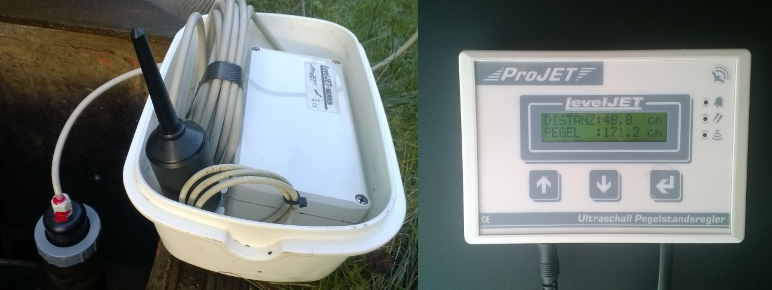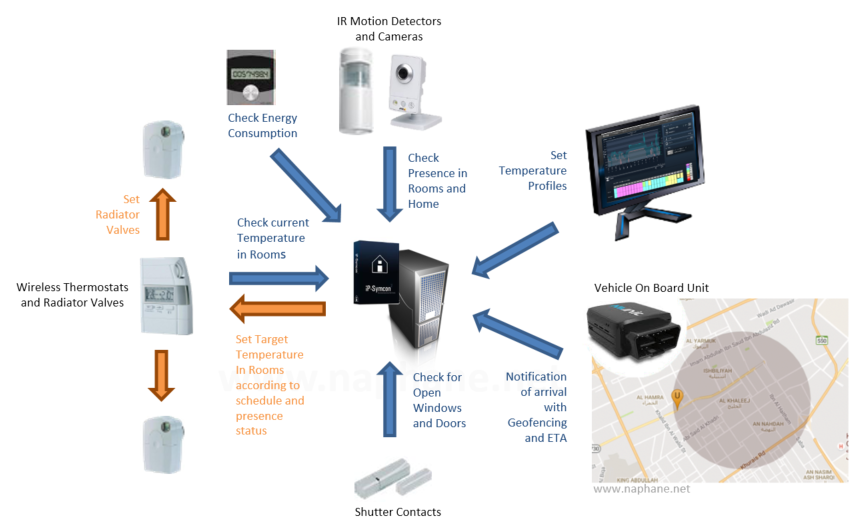
HomeMatic Wireless Room Thermostat and Radiator Valve.
I installed in every room sets of HomeMatic wireless Thermostats and radiator valves to be placed on the heaters. The system is using the BidCoS protocol (Bidirectional Communication Standard) with a frequency of 868MHz and is more reliable than the unidirectional FS20. It was quite unique when I set it up in 2005 but in the meantime, several similar systems exist using various protocols. The additional HomeMatic USB or LAN gateways allow a computer to communicate with the thermostats to get the current temperature and moisture and set the target temperature. The thermostats in turn automatically adjust the valves as a function of the required temperature target. While the thermostats use algorithms to optimize the heating cycles, some intelligence needs to be added to it to achieve both optimal comfort and energy savings.
LEARNING THE USERS TEMPERATURE PREFERENCES...
I first developed a web interface in IP-Symcon to manually set the target temperature for each day in 30 mn steps. When the current temperature is modified by the user, it is automatically set for every following week on the same day and time. In that way, the system learns progressively the preferences of the user according to days and time. The temperature increments are adjusted automatically for a progressive heating or cooling. In addition, dates can be set for holidays or absence during which the heaters are shut off.

Web Interface for setting and displaying the current and target temperatures and the radiator valve opening.
PRESENCE DETECTION
As a next step, I added motion, door and window shutter sensors to the system for presence detection to better adjust the temperature on a daily basis according to the presence of people in the home or in certain rooms. When the entrance door is closed and no movement is detected in any room for some time, a flag is set to signify that nobody is at home. The temperature is then decreased by an adjustable number of degrees.
Geofencing
The next challenge was to identify when the user will be back home to determine the right moment when the temperature has to be increased again to achieve a comfortable temperature when the user arrives. Of course, the return time can be set manually in the web interface but that is not smart enough. This has to happen automatically. The solutions are to either learn when the user comes back home every day or for irregular people to track the person on his way home to estimate the arrival. After some trials with the former, I implemented the latter using a Munic OBD dongle to track the car in real-time. The dongle sends position data via a webhook mechanism to IP-Symcon where I estimate the Time of Arrival using geofencing and routing APIs from renowned map providers. The temperature can be set back to the user's preference a certain amount of minutes before the ETA to allow enough time for the heating. Links to scripts and discussions can be found in the downloads section.

Projet LevelJet Ultrasonic Level Sensor fixed on the outdoor fuel tanker and the wireless Receiver (right) connected to the computer
The last step was to check that the system is working properly and is achieving its intended objective by measuring its impact on the energy consumption. I had to get the electricity consumption data (for electric heaters) and the fuel level in the tanker (for fuel heaters) into IP-Symcon, which was a challenge as I do not have digital readers. I found two interesting devices for that.
- Electricity consumption
The Fast Forward Energy Cam (now Q-Loud, see the script on the downloads page) is a small camera system which can be fixed on the electricity or water readers to read the values on the electrical power meter (with image recognition technology) and send out the data using the m-Bus protocol, a standard for smart meters. The data can then be captured by the computer and processed in IP-Symcon via an USB w-MBus adapter. - Fuel consumption
A Projet LevelJet Ultrasonic Level Sensor (LevelJET-WL9 model) fixed on the outdoor fuel tanker continuously measures the fuel level and sends the data to a wireless Receiver connected to the server via USB. The data can be integrated in IP-Symcon using a COM Port and Splitter Instance.
The figure below provides an overview of the current smart heating system after several years of progressive extension of its functionalities. Since I implemented the system, a dedicated Heating Control Module has been added to IP-Symcon. The Module allows the setting of target temperatures and takes into account presence variables in the rooms to lower the temperature. Geofencing and Energy Consumption functionalities would however still need to be implemented separately. Links to scripts and discussions about how to develop these functionalities can be found in the downloads section.

Overview of High Level Data flows of the Smart Heating System
×
![]()
Comment Box is loading comments...